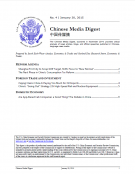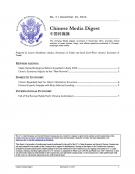×
Filter Results
Filter Results


Staff Paper
This report examines recent upgrades to Taiwan’s patrol fleet and implications for Taiwan’s security.


Staff Paper
As the United States weighs options for responding to the widely publicized cyber attack on Sony Pictures Entertainment in November 2014, for which it has attributed responsibility to North Korea, the perspectives and potential reactions of China are of particular interest. This report analyzes four questions regarding China's position: whether it was involved in the attack, prospects for cooperation with the U.S. response, likely reactions to a U.S. counterstrike in cyberspace, and potential for future deterrence based on U.S. actions.


Staff Paper
On November 29, 2014, Taiwan held a series of local elections for 11,130 positions, including mayors, county magistrates, city and county councilors, township chiefs, and village and borough chiefs. This staff report provides an overview of the election results and assesses their implications for cross-Strait relations from now until Taiwan’s presidential election in 2016.

Staff Paper
This staff report provides an overview of areas of tension and cooperation in China-India relations. It also assesses the implications for the United States of the 2014 election of Prime Minister Narendra Modi in India, India’s evolving strategic calculations, and the growing Indian economy and role in global energy markets. Finally, it discusses areas of potential U.S.-India cooperation in the security and economic realms.

Research
Highlights of this edition: State-Owned Enterprise Reform Expected in Early 2015; China’s Economy Adjusts to the “New Normal”; China’s Repeated Fuel Tax Hikes Criticized as Excessive; Finance Experts Grapple with Risky Internet Lending; Fall of the Russian Ruble Hurts Chinese Automakers.

Staff Paper
China’s land reclamation activities at Fiery Cross Reef likely will result in its first airstrip in the disputed Spratly Islands, which would allow the People’s Liberation Army to alleviate some of its logistical and power projection deficiencies in the South China Sea. This paper analyzes the latest publically-available imagery of Fiery Cross Reef and assesses China’s possible uses for an airstrip.

